Bob and I have lived all over the United States in both small and large towns, transferring as our companies needed us in other locations, doing what we needed to further our careers and climb the corporate ladders. We reached a point in 2006 where we took control, became the masters of our own destinies and decided to leave Madison, WI and move further south. We purchased 23 acres in Licking, MO in 2006 and by 2007 we had moved into our new home. We had always wanted to be back in the country where everything is much prettier and slower and as nature lovers, we quickly assessed what needed to be done to turn our 23 acres into a wildlife sanctuary and something that we could enjoy for the rest of our lives. These changes would also reduce our maintenance requirements for such a large piece of property as we age and can no longer do such strenuous, manual labor.
After taking a stroll around the property today, I realized that we are making a lot of progress towards that goal. Fall is my absolute most favorite time of the year. The air is cooler, the tick and chigger populations are receding and to my delight, the trees put on their most colorful, brightly colored costumes for the grand finale show of the year. As I look around I see the native plants that, during the summer had bright, showy flowers and hosted so many interesting insects, birds and butterflies. Now, these same dying native plants, preparing for their long winter’s slumber, will provide food for the many other forms of wildlife in this area that will depend upon their seeds and dropped fruit during the coming cold months.
Here are just a few of my discoveries along my hike today:
Buck brush – this is the time of year when the buck brush is easy to identify! It’s useful as quail and rabbit cover. The small purplish-red fruit stays on the plant through much of the winter and serves as an emergency wildlife food late in winter or during extreme weather when other foods are depleted. From the looks of it, I’ll have plenty of this available for the wildlife this winter!
Black haw (viburnum)– the blue jays have already cleaned off all the fruit and they were very thorough! Blackhaw is prolific on our property and this grove is spreading quickly.
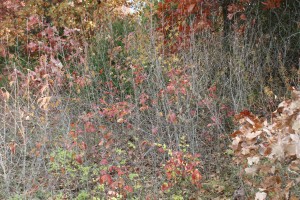
Blackhaw – even though the berries & most leaves are gone, it still makes good escape cover for small animals when being pursued by predators.
Fragrant (aromatic) sumac – provides cover for quail and other small animals due to its growth habit and denser branching. The seeds produced by the plant also provide food for birds and quail.
Rattlesnake master – This is a great grower on my property and it provides a lot of seed that my gold finches love. I’ve seen other birds on it, but the gold finches tend to dominate the seed heads.

Rattlesnake Master
Side oats – lots of seed produced for quail and other birds and provides good brood and nesting cover for quail. This is a great grass to plant because of its ‘bunching’ characteristics that allows the quail chicks to scurry around the base unimpeded. The chicks cannot navigate thick fescue and if slowed down while trying to run, can be caught by predators.
Indian grass – the clumpy nature of this grass also makes it good cover during the summer and brood cover during the breeding season. It produces lots of seed for birds and quail.
Big Blue – this grass is great for nesting & brood rearing for quail and the dense stands provide escape cover and winter cover as well.
Blackberries – besides providing the obvious berries for all types of birds, the berries also draw insects for birds that prefer them. The canes provide good summer cover from the heat and year round escape cover. A healthy crop of blackberries will also eventually kill all the fescue that tries to grow under it.
Acorns – dropped from the oak trees provide lots of food for deer & turkey throughout the winter months.
Acorns
These are just a few of the native plants that we have on our site. If you have native plants on your site, you can help them spread by killing the fescue, and discing and burning at the right times of year. The animals that eat them will also help spread them. Even though they may look ugly now, don’t mow them down just yet! They will provide much needed cover from the winter elements for many animals, as well as food. So get outside, enjoy a walk-about and discover your own native plants!

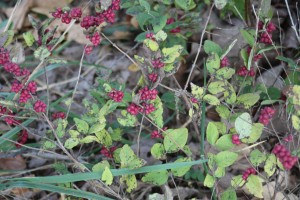
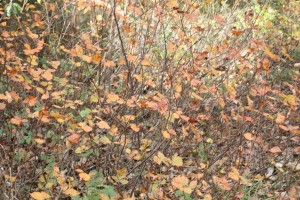
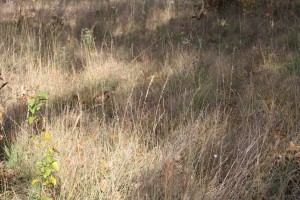
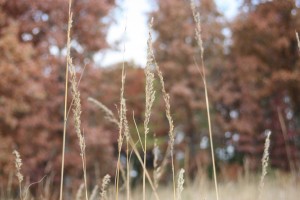
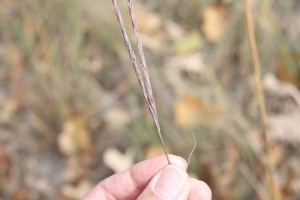
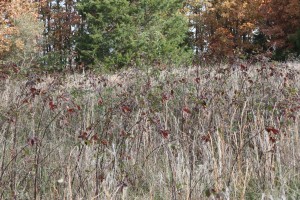
Kathy, thanks for this great survey of native plants here in Missouri.
Were your 23 acres originally pasture? I have ten acres, half of which were pasture, but I’m letting it grow wild now. It already has little pines and little oaks growing on it, after only eleven years, and I didn’t plant any of them.
Hi Aya – thanks for the comment. It was originally all wild pasture. With a lot of fescue. A lot of things have come up without having to plant them (ie, buck brush, goldenrod, partridge pea, etc.). All we did was burn the fields in some areas, and did some discing in other areas. We also thinned out the forest just north of our house. If trees get too thick they will crowd each other out, as well as shade out some of the beneficial native plants. We created what’s called a Savannah in that area.
Yes, a lot of saplings are “volunteers”, spread by birds. 🙂 Interestingly enough, a lot of tree seeds HAVE to be eaten by birds so that they can spread. The acids in the birds tummy and digestive tract are needed to scarify the seed so that it can sprout the next season.